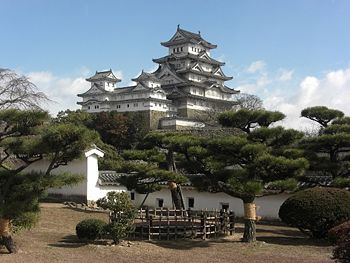Castles in Japan: Difference between revisions
imported>John Stephenson (start) |
imported>Richard Nevell (While surviving castles in Europe are universally stone-built, many that do not survive were timber structures) |
||
| Line 3: | Line 3: | ||
'''[[Castle]]s in [[Japan]]''', as in other countries, were built as defensible fortifications, usually to protect the interests of a local lord. Today, many Japanese towns and cities incorporate a castle or the ruins of one into their modern-day design. Sometimes such castles are not quite what they seem: for example, the one in the city of [[Okayama (city)|Okayama]] (岡山) is a replica housing a museum, situated next to the foundations of the original castle, which was destroyed in [[World War II]] [[incendiary bomb|firebombing]]. Another representative example is [[Morioka]] (盛岡), a city which includes a castle site comprising only ruins, today a park. | '''[[Castle]]s in [[Japan]]''', as in other countries, were built as defensible fortifications, usually to protect the interests of a local lord. Today, many Japanese towns and cities incorporate a castle or the ruins of one into their modern-day design. Sometimes such castles are not quite what they seem: for example, the one in the city of [[Okayama (city)|Okayama]] (岡山) is a replica housing a museum, situated next to the foundations of the original castle, which was destroyed in [[World War II]] [[incendiary bomb|firebombing]]. Another representative example is [[Morioka]] (盛岡), a city which includes a castle site comprising only ruins, today a park. | ||
Japanese castles were typically constructed of wood, though an exception is [[Himeji Castle]] (姫路城 ''Himeji-joo''), which was also built with [[fire]]proof plaster.<ref>''Himeji Castle'': '[http://www.himeji-castle.gr.jp/index/English Virtual Tour - Himeji Castle]'.</ref> It is also notable for its maze of pathways designed to confuse invaders. The castle comprises 83 buildings, and also includes 33 wells in its grounds - one of which attracts many visitors with a [[ghost]]ly tale of murder and haunting. | |||
[[Image:Bitchu-matsuyama-jo.jpg|right|thumb|250px|Fourteenth-century Bitchu-Matsuyama Castle is the highest above sea level in Japan.]] | [[Image:Bitchu-matsuyama-jo.jpg|right|thumb|250px|Fourteenth-century Bitchu-Matsuyama Castle is the highest above sea level in Japan.]] | ||
Revision as of 09:58, 13 January 2013

Castles in Japan, as in other countries, were built as defensible fortifications, usually to protect the interests of a local lord. Today, many Japanese towns and cities incorporate a castle or the ruins of one into their modern-day design. Sometimes such castles are not quite what they seem: for example, the one in the city of Okayama (岡山) is a replica housing a museum, situated next to the foundations of the original castle, which was destroyed in World War II firebombing. Another representative example is Morioka (盛岡), a city which includes a castle site comprising only ruins, today a park.
Japanese castles were typically constructed of wood, though an exception is Himeji Castle (姫路城 Himeji-joo), which was also built with fireproof plaster.[1] It is also notable for its maze of pathways designed to confuse invaders. The castle comprises 83 buildings, and also includes 33 wells in its grounds - one of which attracts many visitors with a ghostly tale of murder and haunting.
Another notable fortress is the fourteenth-century Bitchu-Matsuyama[2] Castle (備中松山城 Bitchuu-Matsuyama-joo) in Okayama prefecture (岡山県 Okayama-ken), which is the highest castle above sea level in Japan. It sits at 1,575 feet (480m), above the town of Takahashi (高梁).[3]
Footnotes
- ↑ Himeji Castle: 'Virtual Tour - Himeji Castle'.
- ↑ Bitchu (備中 Bitchuu) was the name of an old Japanese province.
- ↑ Guide to Japanese Castles: 'Bitchu Matsuyama Castle'.
